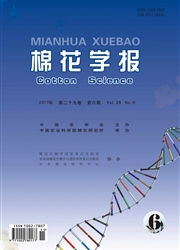

 中文摘要:
中文摘要:
对来自新疆的5个抗黄萎病性不同的棉花品种根系分泌物进行收集分析,测定其对黄萎病菌生长的影响。结果表明:抗病品种的根系分泌物能抑制黄萎病菌生长,与对照相比,其处理菌落直径减少2%-40.00%:耐病品种根系分泌物前期促进菌丝生长,后期表现为抑制作用;感病品种根系分泌物能促进病菌生长。HPLC检测棉花根系分泌物的酚酸有没食子酸、绿原酸、香草酸和对.香豆酸,不同品种其含量有一定差异。在PDA培养基中加入外源酚酸测定其对黄萎病菌生长的影响,发现绿原酸和对一香豆酸在各浓度均抑制病菌生长:香草酸在低浓度(〈400mg·L-1)时前期促进,后期抑制,高浓度时始终抑制病菌生长;浓度小于800mg·L-1时没食子酸对菌丝有明显促进作用。
 英文摘要:
英文摘要:
The root exudates of five cotton cultivars with different resistance to Verticillium dahliae were collected in Xinjiang, and their effects on V. dahliae pathogenic mycelium growth were studied to clarify the relationship between resistance and the root exudates. Results showed that the root exudates of resistant cultivars inhibited mycelium growth by 2%-40% compared with the control, the exudates of tolerant cultivars promoted mycelium growth early on but later inhibited it, and the exudates of susceptible cultivars promoted the mycelium. Phenolic acids in the root exudates of the five cotton cultivars were identified by high performance liquid chromatography(HPLC); gallic acid, chlorogenic acid, vanillic acid and p-coumaric acid were detected in different amounts in the different cultivars. Compared with the control, chlorogenic acid and p-coumaric acid inhibited mycelium growth at various concentrations; vanillic acid inhibited mycelium growth at higher concentrations, but at lower concentrations(〈 400 mg. L-1) promoted mycelium growth early on and inhibited it later; and gallic acid clearly promoted mycelium growth at concentrations of 0-800 mg. L-1.
 同期刊论文项目
同期刊论文项目
 同项目期刊论文
同项目期刊论文
 期刊信息
期刊信息
